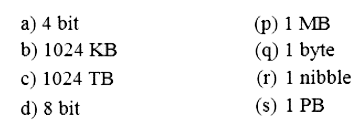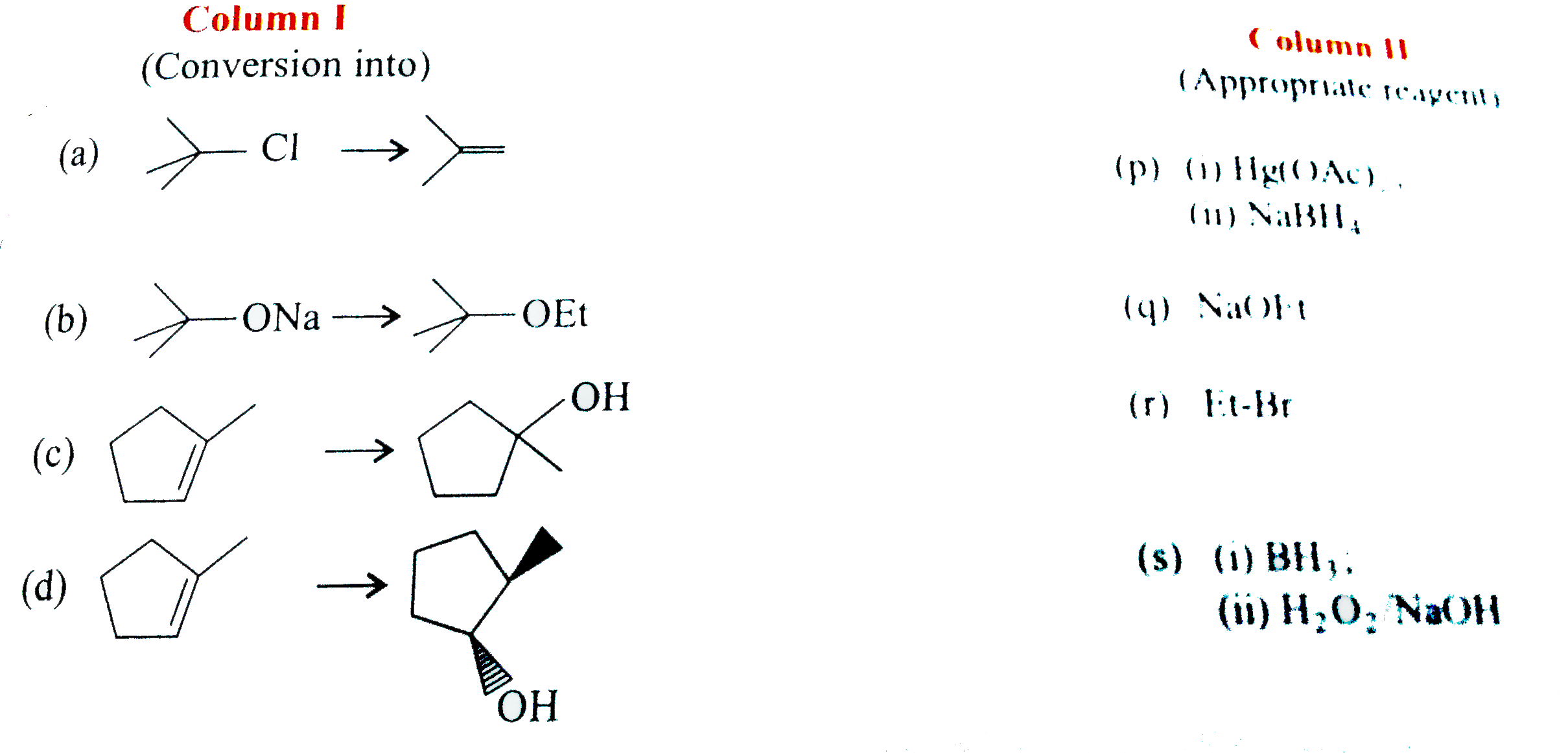Column I (Gas) Column II(Ratio γ=Cp/Cv)(A)Ammonia(p)1.20(B)Carbon dioxide(q)1.30(C)Carbon monoxide (r)1.40(D)Helium (s)1.66
(a) A−s,B−r,C−q,D−p (b) A−p,B−q,C−r,D−s (c ) A−s,B−q,C−r,D−p (d) A−r,B−s,C−q,D−p
The correct Answer is:b
To solve the problem, we need to match each gas in Column I with its corresponding gamma ratio in Column II. The gamma (γ) ratio is defined as the ratio of specific heats (Cp/Cv) for different types of gases.
1. Identify the Gases and Their Types:
- Ammonia (NH3): This is a tetratomic molecule (4 atoms).
- Carbon Dioxide (CO2): This is a triatomic molecule (3 atoms).
- Carbon Monoxide (CO): This is a diatomic molecule (2 atoms).
- Helium (He): This is a monatomic gas (1 atom).
2. Determine the Gamma Values for Each Gas:
- Ammonia (NH3): For tetratomic gases, the gamma (γ) value is approximately 1.20.
- Carbon Dioxide (CO2): For triatomic gases, the gamma (γ) value is approximately 1.30.
- Carbon Monoxide (CO): For diatomic gases, the gamma (γ) value is approximately 1.40.
- Helium (He): For monatomic gases, the gamma (γ) value is approximately 1.66.
3. Match Each Gas with Its Gamma Value:
- Ammonia (A) → 1.20 (s)
- Carbon Dioxide (B) → 1.30 (q)
- Carbon Monoxide (C) → 1.40 (r)
- Helium (D) → 1.66 (p)
4. Formulate the Correct Pairing:
- A-s (Ammonia - 1.20)
- B-q (Carbon Dioxide - 1.30)
- C-r (Carbon Monoxide - 1.40)
- D-p (Helium - 1.66)
5. Select the Correct Option:
- The correct pairing from the options given is (c) A-s, B-q, C-r, D-p.
Final Answer:
The correct answer is (c) A-s, B-q, C-r, D-p.
- Ammonia (NH3): This is a tetratomic molecule (4 atoms).
- Carbon Dioxide (CO2): This is a triatomic molecule (3 atoms).
- Carbon Monoxide (CO): This is a diatomic molecule (2 atoms).
- Helium (He): This is a monatomic gas (1 atom).
- Ammonia (NH3): For tetratomic gases, the gamma (γ) value is approximately 1.20.
- Carbon Dioxide (CO2): For triatomic gases, the gamma (γ) value is approximately 1.30.
- Carbon Monoxide (CO): For diatomic gases, the gamma (γ) value is approximately 1.40.
- Helium (He): For monatomic gases, the gamma (γ) value is approximately 1.66.
- Ammonia (A) → 1.20 (s)
- Carbon Dioxide (B) → 1.30 (q)
- Carbon Monoxide (C) → 1.40 (r)
- Helium (D) → 1.66 (p)
- A-s (Ammonia - 1.20)
- B-q (Carbon Dioxide - 1.30)
- C-r (Carbon Monoxide - 1.40)
- D-p (Helium - 1.66)
- The correct pairing from the options given is (c) A-s, B-q, C-r, D-p.
The correct answer is (c) A-s, B-q, C-r, D-p.
Topper's Solved these Questions
- THERMODYNAMICSBOOK - PRADEEPCHAPTER - THERMODYNAMICSEXERCISE - ASSERTION AND REACTION TYPES QUESTIONS
3 Videos
- THERMODYNAMICSBOOK - PRADEEPCHAPTER - THERMODYNAMICSEXERCISE - LONG ANSWER QUESTIONS
21 Videos
- THERMODYNAMICSBOOK - PRADEEPCHAPTER - THERMODYNAMICSEXERCISE - NCERT EXEMPLAR PROBLEMS WITH ANSWERS, HINTS AND SOLUTIONS( SHORT ANSWER QUESTIONS)
31 Videos
- STRUCTURE OF ATOMBOOK - PRADEEPCHAPTER - STRUCTURE OF ATOMEXERCISE - Competition Focus (JEE (Main and Advanced)/Medical Entrance (IX. Assertion And Reason Type Questions (Type II))
12 Videos
Similar Questions
Column IColumn II(A)Isothermal process(p)q=ΔU(B)Adiabatic process(p)w=−pPΔV(C)Isobaric process(r)w=ΔU(D)Isochoric process(s)w=nRTln(V2/V1)
(a) A−s,B−q,C−r,D−p (b) A−s,B−r,C−q,D−p (c )A−p,B−r,C−q,D−s (d) A−r,B−p,C−s,D−q
View Solution∣∣ ∣ ∣ ∣ ∣ ∣∣Column IColumn II(A)Adenine(p)Purine(B)Thymine(q)Pyrimidine(C)Uracil(r)RNA(D)Deoxyribose(s)DNA∣∣ ∣ ∣ ∣ ∣ ∣∣

View Solution
Knowledge Check
Match the Correct Memory Units.

A. a-r, b-p, C-s, d-q
B. a-p, b-s, c-q, d-r
C. a-r, b-s, c-4, d-p
D. a-r, b-q, c-s, d-pAABBCDDC
Match List -I (Equations) with List -II (Type of processes) and select the correct option.
List -IList -IIEquationType of processes(a)Kp>Q(i)Non spontaneous(b)ΔG∘<RTlnQ(ii)Equilibrium(c)Kp=Q(iii)Spontaneous and endothermic(d)T>ΔHΔS(iv)Spontaneous
View SolutionColumn IColumn II(a)Pencillinp.Antiseptic(b)Chloramphenicolq.Antibiotic(c)Phenolr.Bactericidal(d)Chloroxylenols.Disinfectant
View SolutionColumn I( Solutions mixed)Column II ( Heat evolved)(A)500mLof0.1M HCl acid+200mLof0.2MNaOHsolution(p)4568J(B)200mLof0.2MH2SO4+400mLof0.5MKOHsolution(q)2284J(C)500mLof0.1MHCl+500mLof0.1MNH4OH(r)2760J(D)500mLof0.1Macetic acid +500mLof0.1MNaOH(s)2575J
(a) A−r,B−p,C−s,D−q (b) A−p,B−r,C−q,D−s (c ) A−q,B−p,C−s,D−r (d) A−,B−s,C−p,D−r
View SolutionColumn IColumn II(A)R/L(p)Time(B)C/R(q)Frequency(C)E/B(r)Speed(D)√ε0μ0(s)None
View SolutionMatch the following :

Codes :
(a)qrps(b)rqps(c)qrsp(d)rqsp
View Solutiona,b,c∈R and a, b, c are in A.P. match the entries of column-I with those of column-II.
Column-IColumn-II(a)a2,b2,c2are in A.P.(p)a=b=c(b)a2,b2,c2are in G.P.(q)−12a, b, c are in G.P(c)a2,b2,c2are in H.P.(r)a, b,−12c are in G.P.(d)a + b + c = 3/2(s)b=1/2
View SolutionIf pa=qb=rc=sd and p,q,r,s are in G.P then a,b,c,d are in
View Solution
